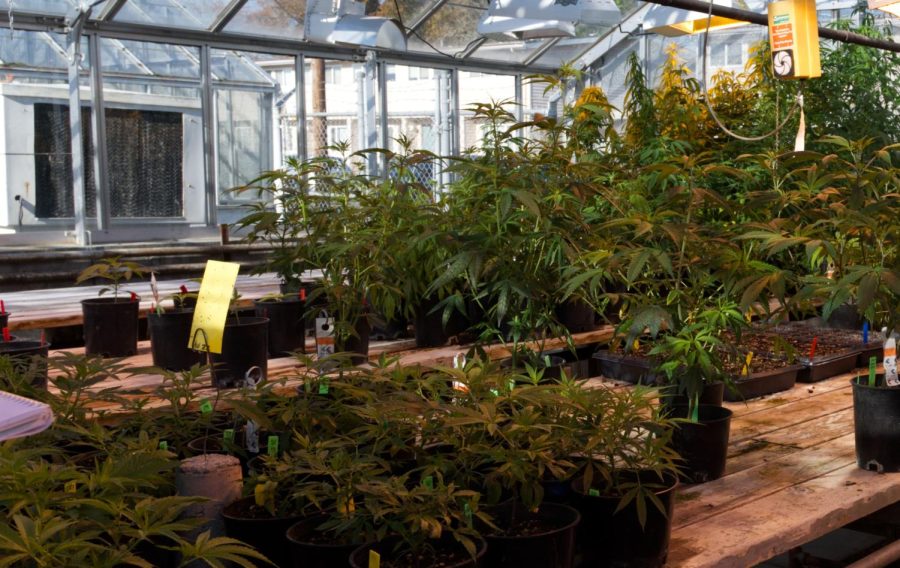Hemp’s ‘long history of human use’ proven useful for food, clothing, medicine and more
A photo taken on Nov. 21, 2022 shows the hemp fields at the Oregon State University research greenhouse. Hemp has been used for food, clothing and more, arriving in 1545 due to Spanish colonization.
March 7, 2023
Last year, researcher and professor at Oregon State University, Richard van Breemen, discovered two cannabinoid acids — found in hemp — that block the infection of human cells from the virus that causes COVID-19.
According to Breemen, cannabidiol acid and cannabigerolic acid block the infection of SARS-CoV-2 by binding to the spike protein found in the virus, blocking the interaction between it and the ACE2 receptor.
“Hemp compounds, like CBDA and CBGA, have a long history of human use,” Breemen said. “Certainly, we (researchers) have a history of finding antibiotics in plants and other organisms like fungi and bacteria.”
According to Breemen, due to hemp having a long history of human use, researchers were able to bypass the safety work that involves animals and go straight to human trials.
He said about a half-dozen clinical trials testing cannabinoids and various other hemp extracts are either in progress or have been completed.
“The pharmaceutical industry has largely abandoned natural products as sources for new drugs because it’s hard,” Breemen said.
Breemen said researchers in pharmaceuticals, with enough funding, would prefer to look at a static selection of molecules, sometimes reaching the hundreds of thousands.
This curated collection is used as a starting point for screening molecules, in order to find potential for new antiviral targets. When a potential molecule is found, it’s synthesized then optimized for medicinal chemistry.
Breemen said hemp has over 100 cannabinoids with possibilities for more active compounds. According to him, other cannabinoids–also found in hemp–can prevent oxidative stress, inflammation and protect against inflammatory response damage, which benefits individuals living with HIV and AIDS.
“I think it’s a good idea to explore nature to find new sources of medicines that could help people,” Breemen said.
Professor of wood science and engineering at OSU and a self-proclaimed “hempy,” John Simonsen, thinks the plant is beautiful.
“In 2018 when [the government] really gave everyone a greenlight on this, after 80 years of prohibition, there was an explosion,” Simonsen said. “That tells you how helpful it is.”
According to Simonsen, hemp seeds contain all the essential amino acids. Any food containing all essential amino acids would make it a complete source of protein.
Also, the oil from hemp seeds can be found in Dr. Bronners soap, paint, cosmetics and a variety of industrial reasons beyond cooking.
Furthermore, cannabidiol–better known as CBD–helps with anxiety, pain and sleep, the three major reasons people use it. CBD derives from the hemp plant.
“Estimates of the number of uses of hemp varies from 5,000 to 50,000, depending on how big of a ‘hempy’ the person speaking is,” Simonsen said. “Food, clothing, shelter and medicine.”
Govinda Shrestha, a hemp extension specialist, has been studying the plant for a year but has had a different experience with hemp since he is from Nepal.
Hemp originally came from Central and Southwest Asia, according to research done by the University of Florida’s Institute of Food and Agricultural Sciences, and arrived in North America in 1545 due to Spanish colonization.
Growing up in Nepal, Shrestha has had different experiences with hemp. The seeds were cooked in different food recipes and the fiber from hemp was used for clothing.
Although hemp flowers are illegal in Nepal, citizens are allowed to use the seeds and fibers for various different reasons.
“My dad, mom and whole family have used (hemp), it’s a part of (our) food culture,” Shrestha said.
Hemp was considered a controlled substance by the Drug Enforcement Agency before 2018, when The Agriculture Improvement Act authorized the production of hemp.
Shrestha studies the quality and crop production of hemp, researching which time of season would produce the best quality of hemp, how to avoid pest infestations and how to utilize hemp byproducts.
“It’s time to invest in research. It’s time to invest in lots of aspects of this crop,” Shrestha said.

























































































































